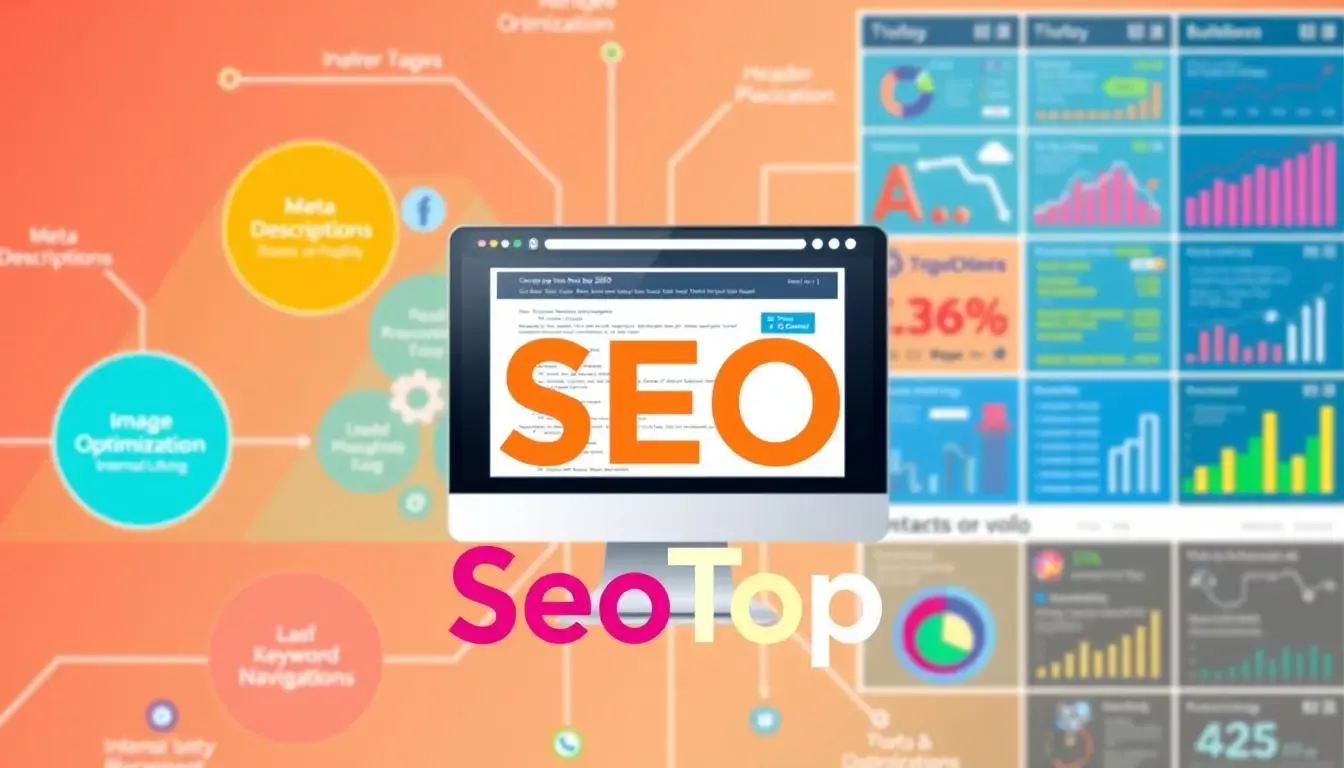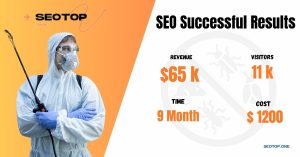Most online experiences start with a search engine. And, most users don’t go past the first page of results. This shows how vital it is to rank higher on search engines like Google.
To make your website more visible, you need to know and use good on-page SEO strategies. This means making your website friendly for search engines. This way, you have a better chance of ranking higher in search results.
By focusing on important on-page SEO factors, you can greatly improve your website’s ranking. This will also bring more people to your site without you having to pay for ads.
Key Takeaways
- Understanding on-page SEO is key for better search engine rankings.
- Optimizing your website’s elements can make it more visible.
- Good on-page SEO strategies can bring more organic traffic.
- Focusing on key on-page SEO factors is vital for online success.
- A well-optimized website can beat its competitors.
What Is On-Page SEO and Why It Matters
On-page SEO is about making your website better for search engines. It uses strategies to improve your site’s ranking. This helps more people find your website.
The Definition and Scope of On-Page SEO
On-page SEO includes keyword research, content optimization, and meta tags optimization. It makes your site easier for search engines to understand. This way, your site can show up higher in search results.
- Keyword research and implementation
- Title tags and meta descriptions optimization
- Content quality and relevance
- Header tags and semantic HTML structure
On-Page vs. Off-Page SEO: Understanding the Differences
On-page SEO deals with your website’s internal parts. Off-page SEO looks at external factors like backlinks and social signals. Both are key for a strong SEO plan.
How They Work Together for Maximum Impact
On-page SEO sets the base for your site’s ranking. Off-page SEO boosts your site’s trust and authority. Together, they make your website more visible and attract more visitors.
By using good on-page SEO, your site can rank better in search results. This leads to more people seeing your site and possibly making a purchase.
The Most Important On-Page SEO Factors in 2023
SEO is always changing, and 2023 is no different. Several key on-page SEO elements are now more important than ever. As Google updates its algorithms, knowing these factors is key to getting and keeping high rankings.
Evolution of Google’s Ranking Algorithms
Google’s algorithms have changed a lot over time. They now look at more than just keywords. They consider user behavior, content quality, and technical aspects too. This shows how important it is to keep your SEO strategies up to date.
Current Ranking Priorities and Trends
In 2023, some trends and priorities stand out in on-page SEO. These include focusing more on user intent, content relevance, and technical optimization.
User Intent and Content Relevance
Understanding and meeting user intent is now key. This means creating content that’s not just relevant but also valuable to users. Some strategies include
- Doing thorough keyword research to see what users are looking for
- Creating content that directly answers user questions
- Making sure content is engaging, informative, and to the point
Technical Optimization Elements
Technical optimization is also very important in on-page SEO. This includes:
- Optimizing page speed to lower bounce rates and improve user experience
- Making sure your site works well on mobile devices
- Improving Core Web Vitals and page experience signals for better usability
By focusing on user intent, content relevance, and technical optimization, you can greatly improve your website’s visibility and ranking in 2023.
Keyword Research and Implementation
On-page SEO relies on good keyword research and smart use of those keywords. Knowing the right keywords for your content can make your website more visible and ranked higher on search engines.
Finding the Right Keywords for Your Content
Finding the right keywords starts with identifying ones that match your content and audience. Use tools to look at search volume, competition, and related keywords.
Primary vs. Secondary Keywords: Primary keywords are what you aim to rank for. Secondary keywords add context and support. It’s important to use both well in your SEO plan.
Strategic Keyword Placement
After picking the right keywords, place them wisely in your content. Use them in titles, meta descriptions, headings, and the body of your content. Make sure it’s natural and easy to read.
Long-Tail Keywords and Their Value
Long-tail keywords are specific phrases with less competition and higher conversion rates. They bring valuable, targeted traffic to your site.
For example, using “on-page SEO factors for e-commerce websites” instead of just “SEO” can attract more relevant visitors.

By focusing on keyword research and use, you can boost your website’s on-page SEO. This drives more organic traffic and helps improve your search engine rankings.
Title Tags and Meta Descriptions Optimization
Making the perfect title tag and meta description is a fine art. It’s about balancing SEO needs with making users want to click. These elements are key to better search rankings and more clicks.
Crafting SEO-Friendly Title Tags
Title tags are the first thing people see in search results. They’re vital for getting clicks. To make them SEO-friendly, they should be clear, short, and include your main keywords.
Character Limits and Best Practices
It’s important to keep title tags short to avoid being cut off in search results. Google shows the first 55-60 characters. Place your keywords first and make the title engaging and descriptive.
- Keep title tags under 60 characters.
- Include target keywords at the beginning.
- Make sure the title is descriptive and compelling.
Writing Compelling Meta Descriptions That Drive Clicks
Meta descriptions give a quick summary of your page’s content. They’re key to getting more clicks from search results. A good meta description can really boost your click-through rates.
Including Call-to-Actions in Meta Descriptions
Adding a call to action (CTA) in your meta description can prompt users to click. Use phrases like “Learn more” or “Get started.” Make sure your meta description matches what your page offers.
| Element | Best Practice | Example |
|---|---|---|
| Title Tags | Include target keywords; keep under 60 characters | “SEO Tips for Beginners” |
| Meta Descriptions | Incorporate CTAs, accurately reflect content | “Learn SEO basics with our guide. Get started today!” |

Optimizing your title tags and meta descriptions can boost your site’s visibility and clicks. These on-page SEO elements are essential for both search engines and users.
Content Optimization for Search Engines and Users
Content optimization is about pleasing search engines and giving value to users. This balance is key for better rankings and more website visitors.
Creating High-Quality, Relevant Content
To optimize your content, know what makes it great and relevant. High-quality content is well-researched, informative, and engaging. It should offer value and be error-free. Relevant content meets the needs and interests of your audience.

Content Structure and Readability
The structure and readability of your content are vital. Proper formatting and headings make it easier to read.
Paragraph Length and Formatting
Keep paragraphs short and focused. Break up large texts into smaller ones. Use formatting options like bold and italics to highlight key points.
Using Bullet Points and Lists
Bullet points and lists help present complex info clearly. They make your content easier to read and more user-friendly.
| Content Element | Purpose | Best Practice |
|---|---|---|
| Headings (H1-H6) | Structure content | Use hierarchical order |
| Paragraphs | Convey detailed information | Keep them concise |
| Bullet Points/Lists | Present complex information simply | Use for lists and comparisons |
E-A-T Principles in Content Creation
The E-A-T principles (Expertise, Authoritativeness, Trustworthiness) guide Google’s content evaluation. Following these can boost your site’s credibility and ranking.
By optimizing your content, you can increase your website’s visibility. This drives more traffic and enhances the user experience.
Header Tags and Semantic HTML Structure
Using header tags and semantic HTML is key to good on-page SEO. Header tags, from H1 to H6, help organize a webpage. This makes it easier for search engines to understand the content’s order.
Proper H1-H6 Tag Hierarchy
A good header tag order is vital for both users and SEO. Start with an H1 tag for the main title. Then, use H2 tags for subheadings and H3, H4, and so on, for more details. This helps search engines see the page’s content and its relevance.
Incorporating Keywords in Headers
Adding the right keywords in header tags can boost your page’s search visibility. But, it’s important to do it naturally and avoid keyword stuffing. Your headers should be clear, short, and match the content that comes after.
Avoiding Keyword Stuffing in Headers
To steer clear of keyword stuffing, aim for headers that are informative and user-friendly. Mix primary and secondary keywords, but keep the headers natural and not too optimized. For more on semantic markup, check out Saffron Edge’s blog on SEO semantics.
By setting up a proper header tag order and using keywords wisely, you can greatly boost your website’s SEO. Also, using semantic HTML elements like <header>, <nav>, and <footer> makes your webpage’s structure and readability better.

- Use H1 tags for main titles.
- Utilize H2-H6 tags for subheadings and subsections.
- Incorporate relevant keywords naturally in headers.
- Avoid keyword stuffing by keeping headers informative and concise.
URL Structure and Website Architecture
Making your URLs SEO-friendly and organizing your website well is key to being seen more online. A good URL structure makes your site easier to use and helps with search engine rankings.
Creating SEO-Friendly URLs
Creating URLs that are easy to read and understand is important. They should clearly tell users and search engines what the page is about. This is called relevance and descriptiveness.
URL Length and Readability
How long a URL is matters too. Even though there’s no strict limit, shorter URLs are better. They’re easier to share and remember, and they don’t get cut off in search results.
- Keep URLs short and to the point.
- Don’t add extra characters or numbers.
- Use hyphens to make words easier to read.
Site Structure for Better Crawlability
A clear site structure helps search engines find and index your content. This is important for being seen online.
Breadcrumbs and Navigation Optimization
Breadcrumbs and navigation menus are key for both users and SEO. They help users find their way and make your site easier to navigate.
| Navigation Element | SEO Benefit | User Benefit |
|---|---|---|
| Breadcrumbs | Helps search engines understand site structure | Enhances user navigation and experience |
| Clear Menu Structure | Improves crawlability and content discovery | Facilitates easier access to content |
By focusing on these areas, you can boost your website’s SEO and user experience. A well-thought-out URL structure and website architecture are essential for a strong SEO strategy.
Technical On-Page SEO Factors
Technical on-page SEO factors are key to bettering your website’s search rankings and user experience. They help search engines understand and index your site’s content well.
Page Speed Optimization
Page speed is a big deal for rankings and user happiness. It affects how easily search engines can find and read your site.
Mobile Responsiveness
Most people use mobile devices to surf the web. So, making your site mobile-friendly is a must. A responsive design lets your site look great on any screen size.
Core Web Vitals and Page Experience
Core Web Vitals measure how well your site works for users. They look at how fast your site loads, how interactive it is, and how stable it is. Meeting these standards is key for a great user experience.
Here’s a comparison of key technical on-page SEO factors:
| Factor | Description | Impact |
|---|---|---|
| Page Speed | Optimizing images, CSS, and JavaScript | Improves user experience and crawlability |
| Mobile Responsiveness | Adapting design to various screen sizes | Enhances user experience across devices |
| Core Web Vitals | Measuring loading, interactivity, and stability | Directly impacts search engine rankings |
Advanced On-Page SEO Techniques
Advanced on-page SEO techniques can greatly improve your website’s search engine ranking. These strategies make your site more visible and drive more organic traffic. They help your website rank higher in search results.
Schema Markup and Structured Data
Schema markup and structured data are key advanced techniques. They add microdata to your HTML to help search engines understand your content. This makes your site stand out in search results with rich snippets, leading to more clicks.
For example, a product site can show reviews, prices, and availability in search results. Google values structured data, making it a smart SEO move. It boosts your site’s visibility and gives users more info about your content.
Internal and External Linking Strategies
Effective linking is vital for advanced on-page SEO. Internal linking helps users and search engines understand your site’s structure. A good internal linking strategy distributes link equity, improving page rankings.
For ecommerce SEO services, a solid internal linking structure is key. It helps search engines crawl and index product pages efficiently.
Anchor Text Optimization
Anchor text optimization is key for both internal and external linking. Using descriptive and relevant anchor text improves user experience and helps search engines. It’s important to balance keyword-rich anchor text with natural text to avoid over-optimization.
Featured Snippet Optimization
Featured snippets are a coveted spot in search results, boosting visibility and credibility. To get featured, create concise, high-quality content that answers common questions. Use clear headings and lists or tables to increase your chances.
| SEO Technique | Description | Benefit |
|---|---|---|
| Schema Markup | Adding microdata to HTML | Enhanced search result appearance |
| Internal Linking | Linking to other site pages | Improved site navigation and link equity |
| Featured Snippet Optimization | Creating concise, question-answering content | Increased visibility in search results |
“The key to successful SEO is not just about optimizing for search engines, but also about creating a great user experience.”
By using these advanced on-page SEO techniques, you can greatly improve your website’s performance. This keeps you ahead of the competition.
Conclusion: Measuring and Improving Your On-Page SEO Success
Keeping track of your on-page SEO is key to staying ahead online. Use tools like Google Analytics and Search Console to check how your site is doing. This helps you spot what needs work and tweak your SEO plans.
For top on-page SEO, make sure your content is great and meets your audience’s needs. Make sure your site works well on mobile, is easy to navigate, and loads fast. Also, keep your content fresh to keep search engines interested.
Improving your SEO is a continuous job. Keep an eye on your keywords, update your meta tags, and work on your site’s links. This will help more people find your site, bringing in more visitors and helping you meet your online goals.





